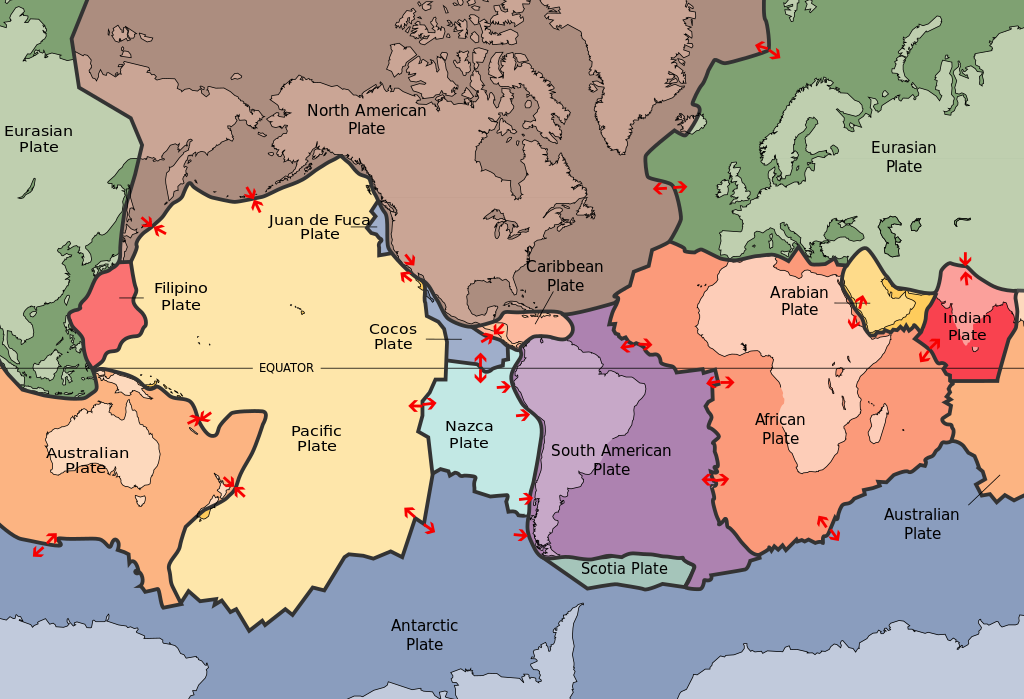12. Plate Tectonics
Summary The continents on Earth’s surface are moving at a typical speed of a few centimeters per year. They collide with each other and separate from each other, they form mountains and rifts. Every about 500 million years they form a supercontinent on Earth’s surface which unifies most of the land masses, with the last supercontinent being Pangaea which broke up about 175 million years ago.
Keywords Continents; Earthquakes; Volcanism

The supercontinent Pangaea 200 million years ago at the beginning of the Mesozoic Era. It consisted of the two loosely connected parts Laurasia and Gondwana which later drifted away from each other and split into the continental shapes which we know today. (© Lennart Kudling (User:LennyWikidata) / Wikimedia Commons / CC-BY-3.0)
Since the Earth’s surface became cool enough to let continents form in the beginning of the Archean Eon (4.0 – 2.5 Ga), tectonic plates – which include the continents – on the Earth’s crust were moved due to heat convection in the Earth’s mantle. While the geological community rejected the idea of continental drift which was put forward by German geologist Alfred Wegener in 1912, it became widely accepted in the 1960s when the process of seafloor spreading was discovered: It was found that, while rocks on continental plates were up to 3.8 billion years old, the ages of sea floors did not exceed 200 million years, as they were constantly produced at mid-ocean ridges and subducted in regions where they hit lighter continental plates – just as the relatively heavy basalt oceanic plates moved across Earth’s surface, so did the relatively light granite continental plates. Nowadays it is known that the spreading and the subduction areas of oceanic plates as well as regions where continental plates move relative to each other are prone to volcanism and earthquakes, one example for that being the Ring of Fire which stretches from the Andes in South America via the North American west coast, Alaska, Japan and southeast Asia to New Zealand.
One method to determine the age of sea floors was to link the reversal times of the Earth’s magnetic field – which occurred every about 500,000 years – with the varying magnetization of the sea floor rocks with increasing distances to mid-ocean ridges, as it was aligned to the direction of the Earth’s magnetic field during its formation. Also the speed of continents – typically a few centimeters per year which corresponds to the growing speed of human fingernails – can nowadays be measured by global navigation satellite systems such as GPS, and plate tectonics became a central building block of modern geology.
Plate tectonics lets the Earth’s continents form supercontinents – continents encompassing nearly all land masses on Earth – every around 300-500 million years. The last supercontinent in the past is called Pangaea and was surrounded by the superocean Panthalassa. It existed during around 335-175 million years ago – in the late Paleozoic Era (541-252 Ma) and the early Mesozoic Era (252-66 Ma) –, after which it splitted into the continents Laurasia and Gondwana. Laurasia eventually became Europe, Asia and North America, and from Gondwana Africa, South America, Australia, India, Arabia, Antarctica and the Balkans emerged.

The tectonic plates nowadays, together with their current directions of movement. (© Map: USGS, Description: Scott Nash / Wikimedia Commons / Public Domain)
The Indian Plate splitted from Antarctica 100 million years ago, drifted northwards and collided with Asia around 50 million years ago, by which the Himalayas were formed. The break-up of Pangaea is continuing today in the Red Sea Shift and the East African Rift. Currently, from the perspective of the Eurasian plate, the North American plate is moving away – even though it will reverse and return to Eurasia in around 100 million years –, as new oceanic crust is formed along the Mid-Atlantic Ridge; and the African plate is approaching and will close and elevate the Mediterranean Sea. The next supercontinent is expected to will have formed in around 250 million years.
